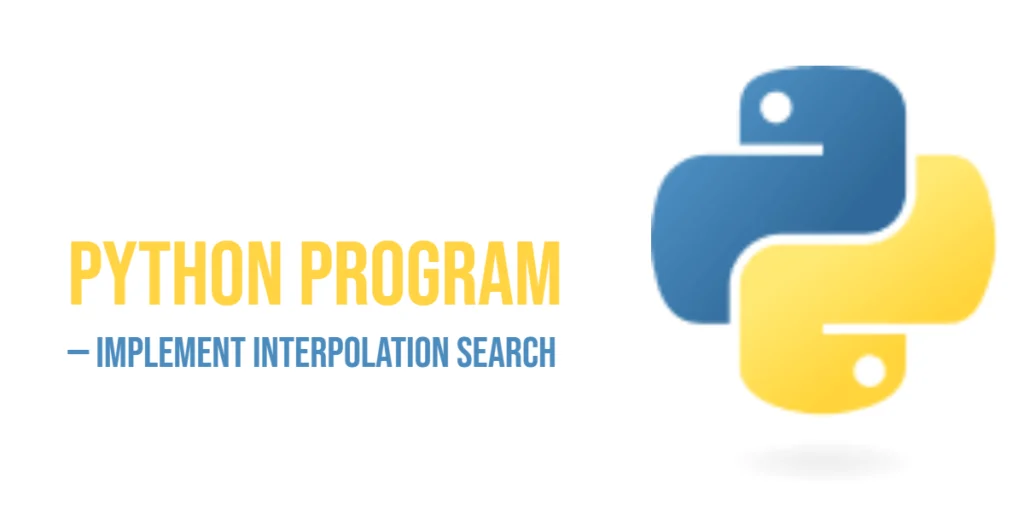Efficient searching is a core skill for any programmer, and interpolation search is a clever algorithm that helps you find elements quickly in a sorted dataset. Unlike linear search, which checks each element one by one, or binary search, which divides the list in half, interpolation search estimates the position of the target based on its value relative to the first and last elements. This makes it particularly effective for uniformly distributed data, where it can locate the target faster than binary search in many cases. Learning interpolation search in Python gives beginners an opportunity to understand both algorithm optimization and practical implementation in programming.

with hands-on learning.
get the skills and confidence to land your next move.
Interpolation search is commonly applied in real-world scenarios, such as looking up records in a database, searching for phone numbers, or quickly finding values in ordered datasets. Understanding how this algorithm works teaches beginners the importance of adapting the search strategy to the data pattern, improving both speed and efficiency. In this article, we will explore multiple ways to implement interpolation search in Python, including iterative, recursive, and function-based methods, making it easy for beginners to follow along.
Program 1: Iterative Interpolation Search
This program demonstrates a simple iterative approach to interpolation search. It calculates an estimated position and adjusts the search range until the target element is found.
numbers = [10, 20, 30, 40, 50, 60, 70]
target = 40
low = 0
high = len(numbers) - 1
found = False
while low <= high and target >= numbers[low] and target <= numbers[high]:
pos = low + ((target - numbers[low]) * (high - low) // (numbers[high] - numbers[low]))
if numbers[pos] == target:
print(f"Element {target} found at index {pos}")
found = True
break
elif numbers[pos] < target:
low = pos + 1
else:
high = pos - 1
if not found:
print(f"Element {target} not found in the list")In this example, the program estimates the probable position of the target using the interpolation formula. The search space is narrowed iteratively, making the search faster than linear search, especially on uniformly distributed data. Beginners can see how this estimation method allows the program to “jump” closer to the target instead of checking every element.
Program 2: Recursive Interpolation Search
Recursion can also be applied to interpolation search, where the function calls itself with a smaller search range until the target is located or determined to be absent.
def interpolation_search_recursive(numbers, target, low, high):
if low > high or target < numbers[low] or target > numbers[high]:
return -1
pos = low + ((target - numbers[low]) * (high - low) // (numbers[high] - numbers[low]))
if numbers[pos] == target:
return pos
elif numbers[pos] < target:
return interpolation_search_recursive(numbers, target, pos + 1, high)
else:
return interpolation_search_recursive(numbers, target, low, pos - 1)
numbers = [5, 15, 25, 35, 45, 55]
target = 35
result = interpolation_search_recursive(numbers, target, 0, len(numbers) - 1)
if result != -1:
print(f"Element {target} found at index {result}")
else:
print(f"Element {target} not found in the list")The recursive approach shows how the problem can be broken into smaller subproblems. Each call focuses on a narrower range, making it easier to understand recursion and how interpolation search reduces the search space efficiently. Beginners can practice recursion while learning how the algorithm “zooms in” on the target element.
Program 3: Interpolation Search Using a Reusable Function (Iterative)
This program wraps the interpolation search logic in a reusable function, making it easy to call with different datasets and targets.
def interpolation_search(numbers, target):
low = 0
high = len(numbers) - 1
while low <= high and target >= numbers[low] and target <= numbers[high]:
pos = low + ((target - numbers[low]) * (high - low) // (numbers[high] - numbers[low]))
if numbers[pos] == target:
return pos
elif numbers[pos] < target:
low = pos + 1
else:
high = pos - 1
return -1
numbers = [2, 4, 6, 8, 10, 12]
target = 8
result = interpolation_search(numbers, target)
if result != -1:
print(f"Element {target} found at index {result}")
else:
print(f"Element {target} not found in the list")Using a function allows the search logic to be reused across different scenarios. Beginners can see the benefit of modular programming and how separating logic into a function makes the code cleaner, more maintainable, and easier to understand.
Program 4: Interpolation Search on a Large Dataset
This program demonstrates the efficiency of interpolation search on a larger, uniformly distributed dataset, showing how quickly it can locate the target.
numbers = list(range(0, 500, 5)) # 0, 5, 10, ..., 495
target = 245
low = 0
high = len(numbers) - 1
found = False
while low <= high and target >= numbers[low] and target <= numbers[high]:
pos = low + ((target - numbers[low]) * (high - low) // (numbers[high] - numbers[low]))
if numbers[pos] == target:
print(f"Element {target} found at index {pos}")
found = True
break
elif numbers[pos] < target:
low = pos + 1
else:
high = pos - 1
if not found:
print(f"Element {target} not found in the list")Even with 100 elements or more, interpolation search quickly finds the target because it estimates the likely position intelligently. Beginners can compare this performance with linear and binary search to understand why estimation can be faster in uniformly distributed data.
Program 5: Interpolation Search with Error Handling
This program demonstrates a safe approach, including checks for empty lists and prevention of division by zero, making it suitable for real-world applications.
def safe_interpolation_search(numbers, target):
if not numbers:
return -1
low = 0
high = len(numbers) - 1
while low <= high and target >= numbers[low] and target <= numbers[high]:
if numbers[high] == numbers[low]:
break # prevent division by zero
pos = low + ((target - numbers[low]) * (high - low) // (numbers[high] - numbers[low]))
if numbers[pos] == target:
return pos
elif numbers[pos] < target:
low = pos + 1
else:
high = pos - 1
return -1
numbers = [10, 20, 30, 40, 50]
target = 30
result = safe_interpolation_search(numbers, target)
if result != -1:
print(f"Element {target} found at index {result}")
else:
print(f"Element {target} not found in the list")Adding error handling makes the algorithm more robust. Beginners can learn the importance of practical considerations like empty lists or uniformity checks while implementing efficient algorithms.
Frequently Asked Questions (FAQ)
Interpolation search is efficient, but beginners often have questions. Here are some common ones with clear explanations.
Q1: What is interpolation search used for?
Interpolation search is used to quickly find elements in a sorted, uniformly distributed list, often performing faster than binary search.
Q2: Can it work on unsorted data?
No, the list must be sorted. Searching an unsorted list will produce incorrect results.
Q3: Is interpolation search always faster than binary search?
It is faster when the data is uniformly distributed, but binary search may perform better on non-uniform datasets.
Q4: Can recursion be used for interpolation search?
Yes, recursion can repeatedly narrow the search range until the target is found.
Q5: Why is interpolation search important for beginners?
It teaches estimation-based searching, efficiency, and algorithm adaptation, building foundational programming skills.
Conclusion
Interpolation search is a powerful technique for searching efficiently in sorted and uniformly distributed datasets. By implementing it using iterative, recursive, function-based, and safe approaches in Python, beginners can learn how to estimate positions intelligently and reduce search time.
Practicing these programs helps you understand lists, loops, recursion, and practical error handling. Start with small datasets, experiment with recursion, and explore robust implementations for real-world scenarios. The more you practice, the stronger your understanding of efficient searching techniques and algorithmic thinking will become, preparing you for more complex programming challenges.







